1936 was a key year for the Ilmavoimat. This was the year in which the first monoplane fighters – the Fokker D.XXI were ordered. The 1936 Ilmavoimat Procurement Program also saw the purchase of Bristol Blenheim medium bombers and ordering of the new VL Viima II Trainers – and all were to be built by the newly completed VL Factory outside Tampere. A very small number of other aircraft types were also ordered in 1936, mostly for further and much more detailed evaluation. The outbreak of the Spanish Civil War in July 1936 would also have its impact, with the Defence Budget for 1937 being substantially increased and additional funding for the 1937 procurement program being made available to the Ilmavoimat.
In addition, 1936 was also the year in which financial provision was made for the first aircraft purchases for the Merivoimat Air Arm, establishing this as a combat force in its own right.
VL Viima (“Wind”) II Primary Trainers – ordered 1936
The Viima I and II aircraft were two-seat mixed structure bi-plane primary trainer aircraft with a fixed undercarriage.
Designed by A. Ylinen (VL’s chief designer at this stage) the type was developed by VL to augment and eventually to replace the Smolik primary trainers. A prototype of the aircraft was ordered by the Ilmavoimat on 7 Feb, 1934 and the first flight occurred on 11 Jan, 1935. The second prototype flew for the first time on 12 Oct, 1935. The Viima had unequal span, staggered single bay wings built around two box spars with plywood ribs. The interplane struts were N shaped. The wings were fabric covered and carried four ailerons in all; the upper and lower ailerons were externally linked. The fuselage and tail unit were constructed of chrome-molybdenum steel and fabric covered. The tail-plane, mounted on the top of the fuselage, was wire braced to the small triangular fin. Both fin and tail-plane were adjustable on the ground. The wide chord, deep rudder reached to the bottom of the fuselage between divided elevators. The rudder carried a trim tab and the elevators a Flettner flap. The cockpits were close together, the forward one at mid-chord with a cut-out in the upper wing to enhance visibility. Dual control was fitted. The undercarriage was of the split axle type, with the faired main legs attached to the fuselage forward of the wings and braced by rearward struts. It used low pressure tyres and rubber in compression springing. A tailwheel was fitted. The Viima was powered by an uncowled Siemens-Halske Sh 14 radial engine.
Evaluation proved the aircraft to be satisfactory and the Ministry of Defense ordered 60 Viima II’s on 27 June, 1936. They were delivered over December 1936 to July 1938. An additional 10 Viima II’s were ordered by the Ministry of Defence at the same time for the Air Defence League and these were delivered over the same period. Small numbers continued to be built to replace Viima’s lost or heavily damaged in training accidents. The Viima II remained in use as a basic trainer until 1962.
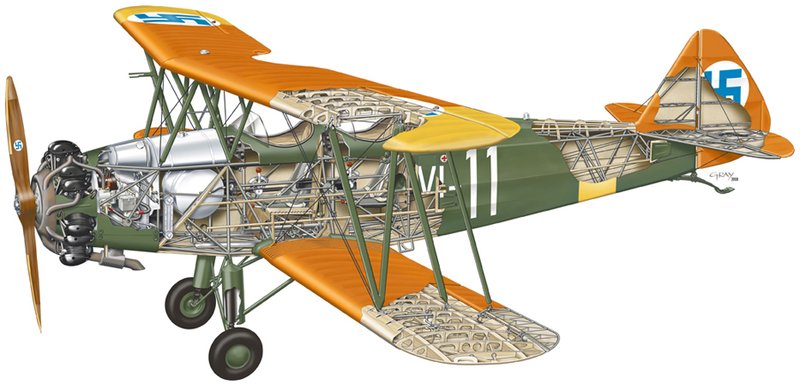
The VL Viima II was a 2-seater, powered by a single Siemens-Halske Sh 14A 7-cylinder single row radial, air cooled, 110 kW (150 hp) with a maximum speed of 121mph, a range of 311 miles and a service ceiling of 14,764 feet. Please note that this cutout illustration is used by permission of the artist, Stewart Gray (www,stewartgray.com)
VL Pyry Advance Trainer – Commissioned in 1936 (First Ordered 1938)
In 1936 it was also decided that in light of the rapid advances in aircraft technology and designs and the decision to purchase monoplane fighter aircraft for the first time, a newer monoplane Advanced Trainer was needed. On 23 Oct, 1936 the Ilmavoimat commissioned a design and a single prototype from the State Aircraft Factory (VL). Work on this aircraft, designated the Pyry, began shortly after the decision was made. Conceptually, the aircraft was to be a two-seated mixed-structure cantilever low wing advanced trainer aircraft with a fixed landing gear.
Fokker D.XXI Fighter – ordered 1936
From 1931 on, the Ilmavoimat had worked hard to continually acquire new aircraft with the limited (but increasing) annual budget at their disposal. Up until 1935, the fighter aircraft purchased had been biplane fighters, in-line with the air forces of other countries. However, by 1936 it was becoming accepted that future fighters would be more modern monoplane designs with enclosed cockpits, higher speeds and heavier armament. The Ilmavoimat had conducted an evaluation program for fighter aircraft in early 1936, focusing largely on a small number of the more modern aircraft available. While biplane aircraft such as the Fiat CR.32 were also considered, it was decided that the performance of the newer monoplane fighters was such that the focus should be on these.
Thanks to Finland’s rapidly expanding exports and friendly relations with all the major european countries (the USSR excepted) as well as with the USA, the Ilmavoimat had the opportunity to test and evaluate all of the most modern fighter aircraft then either in prototype stage or being manufactured. These included the British prototype Hawker Hurricane, the German Me109 and Heinkel He112, the French Dewoitine D.500 and Morane-Saulnier MS.405 and the American Seversky P-35, Vought V-141 and the Curtiss P-36 Hawk as well as the Fokker D.XXI.
While the competing aircraft were all good designs, as far as the Ilmavoimat Procurement Team were concerned the Fokker D.XXI had four major advantages – it was half the price of the comparable British, German, French and American aircraft, it not just a prototype but a finished design, it was available immediately and the aircraft structure was such that it could be manufactured by VL without major technical innovations. There was also the ongoing “will it be delivered or won’t it” issue with Britain, France and Germany as their rearmament programs began to gear up. The Fokker D.XXI also met a good number of the Ilmavoimat’s other criteria for a fighter aircraft including being able to operate under primitive conditions and thus being a rugged and simple design. Another important requirement was that the fighter be able to combat the slow but heavily armed Soviet Tupolev TB-3 bombers. As such, knowing that the Fokker D.XXI would rapidly become obsolete, the decision was made to purchase the Fokker D.XXI’s as an interim aircraft and to follow up on other fighter aircraft as they moved from prototype to production.
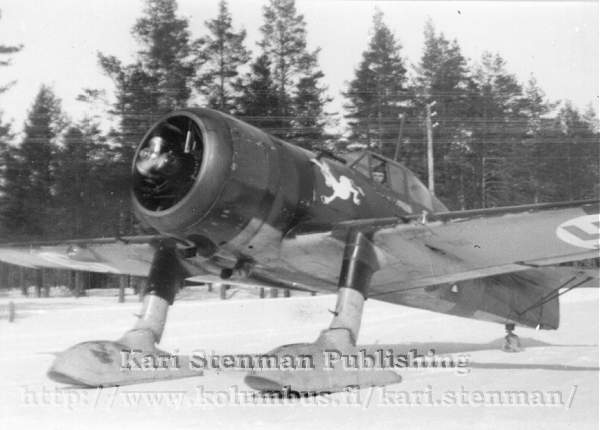
As purchased by the Ilmavoimat, the Fokker D.XXI had fixed landing gear and a relatively underpowered engine (1× Bristol Mercury VIII air-cooled, 9-cylinder, radial, 619 kW-830 hp) for interceptions, it lacked armour and the effectiveness of the weapons was questionable. The radios were limited in range in the beginning and the max level speed was only 285 mph.
On the 15th of March 1936, the Ilmavoimat signed a deal to purchase twenty aircraft outright and simultaneously acquired an unlimited license for Fokker D.XXI production by Valtion Lentokonetehdas (VL). An initial 20-aircraft Series was ordered from VL on March 31st, 1936. Finland was the first export customer for the Fokker D.XXI (and indeed the first production customer – with the Netherlands Luchtvaartafdeling only placing an order after Finland). While consideration was given to a retractable undercarriage, in the end it was agreed that the additional 300kg in weight vs the speed advantages of a retractable undercarriage would cancel each other out. The construction of the D.XXI was typical of all Fokker planes at the time. Fokker had made its name and fame with monoplane airliners in the 1920s and these were all built with a fabric-covered steel tube framework and with wooden wings.
Almost all pre-war Fokkers built in this way and the D.XXI was no different. The rear fuselage was build of steel tubes, with a fabric covering while the wings were made of wood and the front part of the fuselage with the engine-mounting was made of metal, mainly aluminum. The moving parts like the ailerons and rudders were fabric covered as well. The whole construction was not entirely unlike the British Hurricane. Although the whole construction seems to be obsolete compared to the contemporary monocoque built Bf109 and Spitfire, this method of constructing an airplane had its advantages – primarily in that it was relatively easy both to construct and to repair. The engine for the aircraft was specified as the Bristol Mercury VIII nine-cylinder radial engine (825 hp) which was being license-manufactured in Finland (although the Fokker Sales Team at the May 1936 Internationella Luftfartsutstallningen held in Stockholm had offered the DXXI with the 1,100 HP Hispano Suiza 14Ha radial, or the 925 HP Hispano Suiza liquid cooled engine as alternatives to the Mercury – either would have offered increased performance).
The Netherlands built fighters were transported to Finland between 4 Nov and 13 Nov, 1936. When the first consignment was ready in the Netherlands, Ilmavoimat Capt. G. E. Magnusson together with a small number of other pilots flew the acceptance test flights over late 1936. Capt. Magnusson had been attached for five months to the best French fighter regiment in 1933, flying in the “Georges Guynmer” squadron and was to go on to fly as a volunteer in the Spanish Civil War, bringing valuable lessons back to the Ilmavoimat. Capt. Magnusson thought that it was as important to check the capabilities for possible fighter-to-fighter combat so he flew a rigorous test profile for the Fokker. He noticed that it was possible to disengage the fighter against faster fighters by diving the Fokker. This observation turned out to be very important in the Winter War against the faster Soviet fighters. Capt. Magnusson also wasn’t happy with the idea of using long range gun shooting in the Fokkers. He thought that the aircraft would be more successful in close-range machine gun intercepts. Test flights proved that he was right.
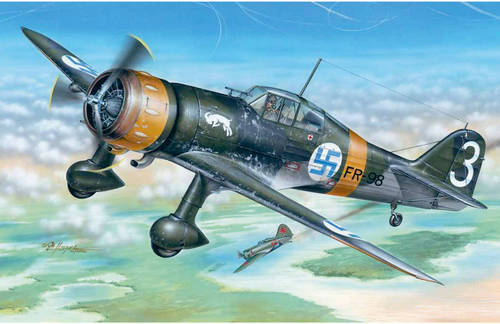
In Ilmavoimat service, the Fokker D.XXI performed better and for much longer than for the Dutch. Against the aircraft of the Soviet Air Force, the Fokker was more evenly matched than it had been against the Luftwaffe, and its rugged design with a radial engine and fixed undercarriage made it very suitable for Finnish conditions
These aircraft were the first monoplane fighter aircraft acquired by the Ilmavoimat and they formed the initial nucleus on which to train pilots, build experience and develop fighter tactics. The State Aircraft Factory (VL) found the Fokker D.XXI relatively straightforward to build, indeed they managed to improve substantially on Fokker’s production times and deliver the aircraft at an even cheaper unit price. Partially as a result of this, and partially due to the ever increasing prospect of a European-wide war, the initial VL order for 20 of the aircraft (in addition to the 20 purchased outright from Fokker) was increased by another 20 in mid-1936 and VL went on to build and deliver forty Fokker D.XXI’s over the period late-1936 to early 1938, with one per week rolling of the construction line by mid-1937 (at which time, 60 Fokker D.XXI’s were in service, equipping three fighter squadrons).
Overall, the Fokker D.XXIs were not quite obsolete as the Winter War broke out – they lacked armour and the effectiveness of the weapons (four 7.7 mm Browning machine guns configured with either 4 in the wings or 2 in the wings and 2 on the fuselage) was questionable. However, in 1936 they were cheap, they were available and they could be constructed and delivered quickly. A further production run was considered in mid 1937 but at this time it had been decided to switch the construction line over to a newer Fighter which had just been successfully prototyped and had far better performance. However, the sixty Fokker D.XXI’s equipping three Ilmavoimat Reserve Squadrons were used to great effect in the air fighting throughout the Winter War, scoring an impressive kill ratio of 16:1 against Soviet aircraft.
The Fokker D.XXI was of straightforward construction, reliable and easy to maintain and served admirably over the duration of the Winter War. Later in the war, as newer models of Soviet fighters appeared, the Fokker D.XXI was under-powered and too lightly armed (with only four .30 caliber machine guns) to compete. In Finland, at a later stage the retractable landing gear was tested and the Fokker D.XXI gained some 20 km/h in speed – but lost a lot of climbing speed. After the end of the Winter War, two Fokker D.XXIs were tested with the Finnish-manufactured Hispano Suiza 12Y engine and a considerable performance increase was achieved. However, an upgrade program was cancelled as Finland was supplied with lend-lease aircraft from Britain and the United States.
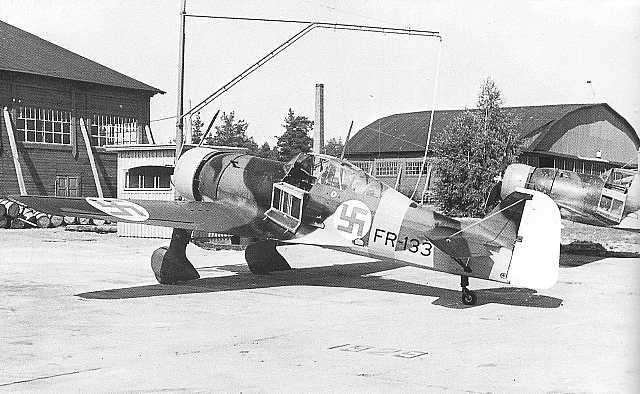
When the Fokker D.XXI flew its first flight it was already bordering on obsolete, the Me-109, Heinkel He-112, Hurricane and Spitfire had already flown with much higher maximum speeds. The maximum speed for the Ilmavoimat Fokkers was 285mph, with a range of 574 miles and a service ceiling of 30,675 ft. Armament consisted of 4 × 7.92 mm FN Browning M36 machine guns, two being fuselage mounted and two wing mounted.
Bristol Blenheim Light Bomber – ordered 1936
The Bristol Blenheim was a twin-engined three-seat all-metal structured bomber and long range reconnaissance aircraft. The Blenheim was one of the first British aircraft to have all-metal stressed skin construction, to utilise retractable landing gear, flaps, have a powered gun turret and variable-pitch propellers. The aircraft was powered with two Bristol Mercury VIII air-cooled radial engines, each of 860 hp (640 kW) and carried a crew of three – pilot, navigator / bombardier and telegraphist / air gunner. Armament as designed comprised a single forward-firing 7.7 mm Browning machine gun outboard of the port engine and a 7.7 mm Lewis gun in a semi-retracting dorsal turret firing to the rear. A 1,000 lb (454 kg) bomb load could be carried in the internal bay (in various configurations (4×250 lb, 2×500 lb internally and 8×40 lb externally). The Blenheim had a maximum speed of 266 mph, a ceiling of 27,260 feet and a range of 1,460 miles.
When it first flew on 12 April 1935, the Blenheim proved to be faster than any fighter in service with the Royal Air Force at the time. To achieve its relatively high speed, the Blenheim had a very small fuselage cross-section. Pilot’s quarters on the left side of the nose were so cramped that the control yoke obscured all flight instruments while engine instruments eliminated the forward view on landings. Most secondary instruments were arranged along the left side of the cockpit with essential items like propeller pitch control actually placed behind the pilot where they had to be operated by feel alone. Like most contemporary British aircraft, the bomb bay doors were kept closed with bungee cords and opened under the weight of the released bombs. Because there was no way to predict how long it would take for the bombs to force the doors open, bombing accuracy was consequently poor.
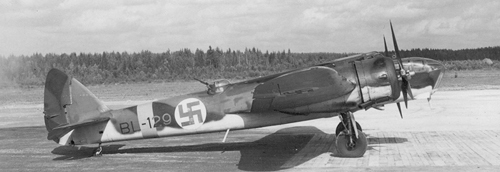
British-supplied MkI Bristol Blenheim prior to being retrofitted with Ilmavoimat ground-attack modifications
The Ilmavoimat had spent considerable time evaluating bombers in 1935 and indeed had evaluated the Blenheim and considered it an excellent light bomber. In discussions with Bristol in early 1936, assurances were made that any Finnish order would be rapidly delivered and accordingly and without further ado, Finland bought 20 Mk. I Blenheim’s from Britain, with the order placed on 6 March 1936. These aircraft were delivered progressively between 26 March, 1937 and 27 March, 1938. At the same time, VL purchased a manufacturing license from the Bristol Aeroplane Company and the Ilmavoimat simultaneously placed an order for 40 Mk I’s with VL. At the same time, VL also obtained a manufacturing license for the Bristol Mercury VIII air-cooled 860 hp radial engine. In 1936, the State Aircraft Factory was continuing to expand aggressively, using additional Government funding to build new production facilities, purchase machinery and hire overseas engineers as well as setting up of training programs and expanding hiring to cope with the multiple lines of aircraft being manufactured.
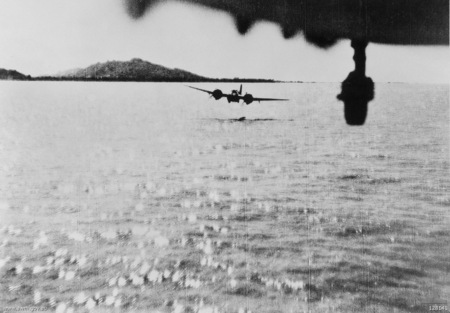
Ilmavoimat Bristol Blenheim’s returning from a ground attack mission on Red Army forces on the Syvari – coming in low across Lake Laatoka– Summer 1940
Work on setting up VL’s Blenheim production line started in mid 1936 and production commenced in January 1937, with approximately two aircraft per month being completed. However, while the aircraft purchased from the UK were as designed, VL and the Ilmavoimat embarked on some redesign. In the Ilmavoimat, unlike many other European Air Forces, the lessons of the WWI ground attack aircraft had not been forgotten – indeed, the Ilmavoimat’s Junkers J1 ground attack aircraft while retired, still sat in a hanger and the reasons for the “armored bathtub” that protected the crew were known (a subsequent post will explore doctrine, including the uses of ground-attack aircraft, in greater detail). The 40 Blenheim’s to be constructed in Finland had design modifications made to equip them as armored ground attack aircraft. They were built with a solid nose containing four 20 mm Hispano-Suiza HS-9 cannon and featured a strengthened structure, pilot armor and better self-sealing fuel tanks. In addition, the dorsal turret was rebuilt to hold two 7.7 mm Lewis gun’s rather than the single gun with which it was originally supplied. This also eliminated one crew position. Vulnerability to flak was reduced by fitting flexible, self-sealing liners in to the fuel tanks but they were still not fully protected.
By the end of 1937, 22 locally built Blenheim’s had been completed with a further 20 were completed up to October 1938, bringing the total delivered by VL to some 42, in addition to the 20 delivered from Britain. Production of Bristol Blenheim’s by VL was discontinued in October 1938 in order to concentrate on production of the new VL Wihuri fighter-bomber. However, following the outbreak of the Winter War, Britain agreed in December 1939 to sell 12 British-manufactured Blenheim’s to Finland. These were flown to Finland arriving on 17th January 1940, with one disappearing in transit and one being badly damaged. In February 1940 Britain agreed to sell a further 12 and these arrived on 26 Feb, 1940. This was a welcome augmentation to the Ilmavoimat’s bomber fleet, bringing the in-service total to 84 Blenheim’s.
1936 – The foundation of the Merivoimat Air Arm
As you may recall from another post, when the Finnish Marine Jaegers (Rannikkojääkärit) were formed as the elite marine infantry arm of the Finnish Navy in late 1934, a small integrated Merivoimat Air Arm was formed up on paper at the same time, with an allocated Table of Organisation of two Fighter Squadrons, two Dive Bomber Squadrons, one Reconnaissance Squadron and one Transport Squadron. Initially there were no aircraft or personnel but in 1936, that would begin to change. The Defence Budget of that year allocated funds to the Merivoimat for the initial establishment of one transport squadron and one reconnaissance squadron. (The 1937 budget included provision for one fighter squadron and one dive-bomber squadron while the 1938 budget provided for a further dive-bomber squadron and a further fighter squadron).
In addition, the existing Maritime Patrol aircraft were transferred from the control of the Ilmavoimat to the control of the Merivoimat while at the same time all of the remaining and now completely obsolete VL A.22 Hansa aircraft were retired – with the personnel from the remaining Hansa-equipped squadrons transferred to the new Merivoimat Air Arm. The remaining aircraft consisted of the 40 Blackburn Ripon IIF’s and the six VL Kotka aircraft that had been built in 1931 as an interim measure until the Ripon’s entered service. With the now strong ties to the US Marines, the joint Merivoimat / Rannikkojääkärit procurement team looked to the Americans among others for aircraft for the new reconnaissance squadron. They were not to be disappointed.
The Merivoimat had differing requirements from the Ilmavoimat. While the Ilmavoimat was largely focused on supporting the Army, the Merivoimat’s focus was on a triad of objectives – keeping the Soviet Navy in their bottle in Kronstadt, securing maritime trade routes for Finland and protecting Finland’s coastline. A new requirement was now added – providing support for the Rannikkojääkärit (Marines) in combat operations along the littoral, and some of the Merivoimat Air Arm funding would in future be allocated to the purchase of aircraft with this role in mind. However, in 1936 the focus was on reconnaissance and transport aircraft. Securing the maritime trade routes was in 1936 largely focused on the Baltic. The existing Blackburn Ripon’s didn’t have the range to do more than patrol the Gulfs of Finland and Bothnia – and in determining the specifications for the aircraft for the reconnaissance squadron, one of the key criteria was to extend the range at which the aircraft could patrol, both to provide intelligence on ship movements and to support Merivoimat operations in the southern Baltic.
Consolidated PBY Catalina – 10 ordered in December 1936 (a further 10 were purchased in early-1939 as the threat of war with the USSR increased)
After extensive investigation and evaluations of a number of different aircraft for use on long-range reconnaissance and patrolling, the Merivoimat settled at last on the Consolidated PBY Catalina. By and large, it was an easy choice to make in the end – while there were many small float-planes on the market, there were few large seaplanes with an extended range in existence. Almost all, such as the Short Empire, had been designed for civilian passenger use rather than as a military aircraft while those that had, like the Consolidated P2Y and Martin P3M, were under-powered and carried lower payloads when compared to the newer PBY Catalina.
The Catalina was the exception – it had originally been designed for the US Navy as a patrol bomber, an aircraft with a long operational range intended to locate and attack enemy transport ships at sea in order to compromise enemy supply lines. With a mind to a potential conflict in the Pacific Ocean, where troops would require resupply over great distances, the U.S. Navy had in the 1930’s invested millions of dollars in developing long-range flying boats for this purpose. Several different flying boats were adopted by the US Navy, but the PBY was the most widely used and produced. The design included a number of new features such as stabilizing floats which were retractable in flight to form streamlined wingtips – another aerodynamic innovation and one which was licensed from the Saunders-Roe company.
The first US Navy PBY Catalina’s had entered service with VP-11F in October 1936 and the final evaluation of the aircraft was carried out by two Merivoimat crews attached to this Squadron. The final reports from the aircrews were enthusiastic, confirming the results of the evaluation and test programs, and an order for 10 aircraft was placed in December 1936 (at a not insignificant cost of USD$90,000 per aircraft plus a like amount for spares – close to USD$200,000 per aircraft in the end). In fact, the cost was such that the purchase of other aircraft for the Merivoimat Air Arm was postponed, with all the available funding going to the purchase of the Catalina’s.
The Merivoimat aircraft however had several differences from the basic PBY. The most obvious upgrades were to the bow, which was sharpened and extended by two feet, and to the tail, which was enlarged and featured a new shape. Other improvements included larger fuel tanks, increasing range by 50%, and stronger wings permitting a 2,000 pound (908 kg) higher gross takeoff weight. An auxiliary power unit was installed, along with a modernized electrical system, and the weapons were upgraded with continuous-feed mechanisms. While the base model had a range of 2,520 miles, the Merivoimat model as delivered could now operate with a range of 3,750 miles, making it capable of patrolling not only the Baltic but also the Arctic and Northern Atlantic approaches to Finland’s Arctic port of Petsamo – and Petsamo was increasingly being looked at as a strategic access point for Finnish trade in the event of a new European War.
With the large industrial capacity of the United States, the Merivoimat order was easily met and delivery of the aircraft took place in mid 1937. Merivoimat crews traveled to the US in early summer and undertook training with the US Navy VP-11F Squadron, then tested the aircraft at the Consolidated factory before carrying out a formation flight to Finland, flying to the Azores, then to Portugal, Britain, across the North Sea to Sweden and then to Helsinki, where they were greeted on arrival by crowds of spectators as well as the President of Finland, the Prime Minister, the Minister of Defence, Marshal Mannerheim, the heads of the Merivoimat and Ilmavoimat and numerous other officials.
Powered by 2 900 hp (671 kW) Pratt & Whitney R-1830-64 Twin Wasp engines, the Merivoimat Air Arm Catalina’s as delivered had a maximum speed of 196 mph, a cruising speed of 125 mph, a range of 3,750 miles and could carry 4,000 lbs of bombs, depth charges or torpedoes. They flew with a crew of 8 – a pilot, co-pilot, bow turret gunner, flight mechanic, radioman, navigator and two waist gunners – and were armed with 5 machines guns – two in the nose turret, one in a ventral hatch at the tail and one in each waist blister.
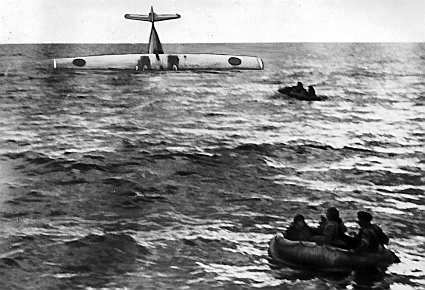
June 1940: No war occurs without losses – an Ilmavoimat PBY Catalina shot down over the Gulf of Finland by Soviet fighters that had evaded the Ilmavoimat fighter patrols. The crew escaped and were later picked up by Merivoimat Patrol Torpedo Boats.
In Merivoimat Air Arm use during the Winter War, the PBY Catalinas patrolled much of the Baltic and were used extensively to combat Soviet submarines, a number of which they sank. The Catalinas were well-suited for their role as patrol aircraft,with the aircraft’s parasol wing and large waist blisters allowing for a great deal of visibility and combined with its long range and endurance, made it well suited for the task. The Merivoimat Catalinas served for the duration of WW2 and well into the 1960’s – and they participated in some of the most notable engagements of the Merivoimat, including the famous Helsinki Convoy of late April 1940, where they provided early warning of the approaching German naval ships. They also patrolled the Arctic approaches to Finland (and later, as the Norwegian ports were used for imports and exports, to Norway), warning of the approaching Soviet invasion force heading for Petsamo at the start of the Winter War, spotted the German ships heading for Narvik in May 1940 and escorted convoys of Finnish merchant ships as far as Iceland and the UK for the duration of WW2, protecting them from German U-boats in the daylight hours.
Following Finland’s entry into WW2 on the side of the Allies, the US supplied the Merivoimat with an additional two squadrons of PBY Catalina’s as well as making up losses in the existing squadron. Later in WW2, with Finland at war with Germany, the Merivoimat Catalina Squadron developed specialist expertise as night convoy raiders. Equipped with state-of-the-art magnetic anomaly gear supplied by the US and painted flat black, these “Black Cats” attacked German supply convoys along the southern Baltic coast at night. They were surprisingly successful in this unorthodox role. They also carried out mine-laying operations along the German-held coasts of the Baltic, operating as far south as Denmark, bottling up ports and shipping routes. In late 1944, their precision mining flights sometimes exceeded 20 hours in duration from as low as 200 feet in the hours of darkness.
The 1936 Ilmavoimat Procurement Program, with its purchase of the Fokker D.XXI Fighters, built on the foundations for the modernisation of the Ilmavoimat’s Fighter Arm that had already been established. The purchase of the first monoplane fighters was a bold step, more were to follow.
Previous Page: The 1935 Ilmavoimat Procurement Program
Next Page: The 1937 Ilmavoimat / Merivoimat Air Arm Procurement Program
Return to Table of Contents for “Punainen myrsky – valkoinen kuolema” (Red Storm, White Death)
 Copyright secured by Digiprove © 2013 Alternative Finland
Copyright secured by Digiprove © 2013 Alternative Finland


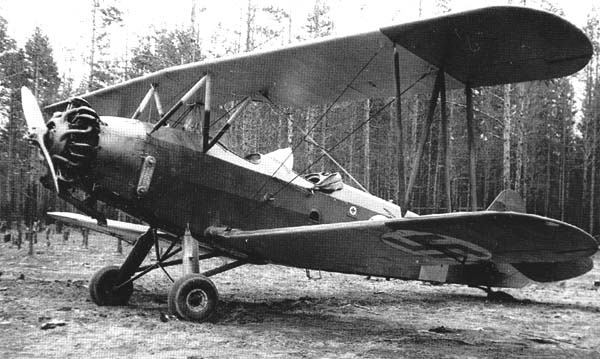
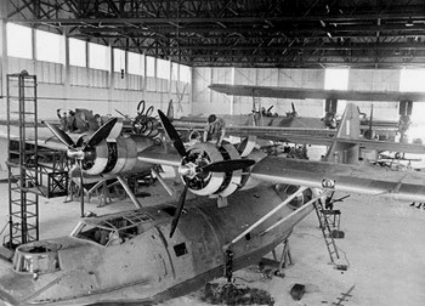
One Response to The 1936 Ilmavoimat Procurement Program